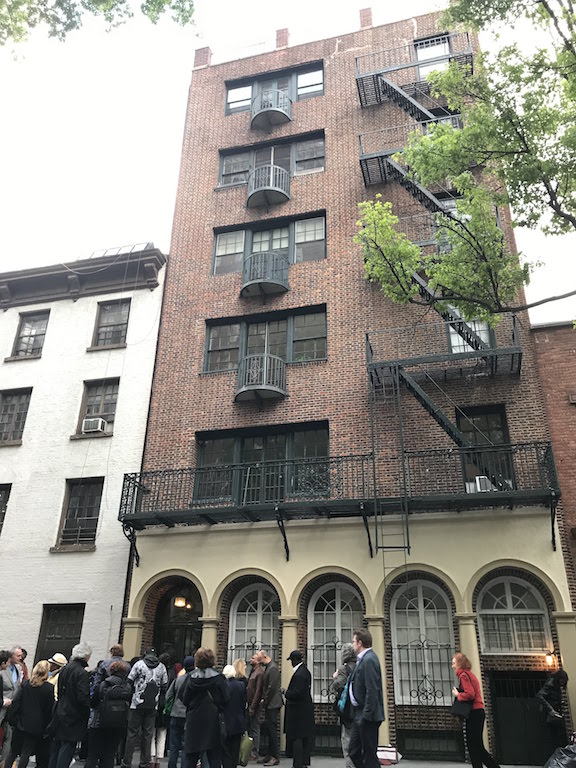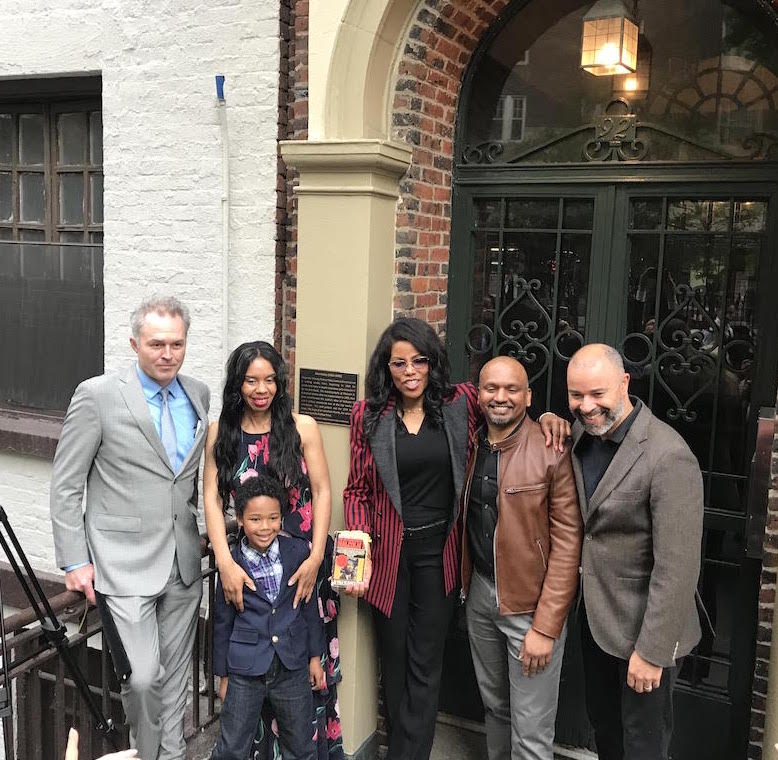BY GABE HERMAN | Village Preservation dedicated a historic plaque last week to mark the former Grove St. home and studio of famed author Alex Haley.
During the 1960s, Haley had a basement apartment at 92 Grove St., between Waverly Place and W. Fourth St. It was there that he conducted more than 50 interviews with Malcolm X, starting in 1963. These sessions would eventually lead to Haley’s first book, the 1965 classic “The Autobiography of Malcolm X: As Told to Alex Haley.”
Haley would go on to write “Roots: The Saga of an American Family.” The 1976 book would earn him the Pulitzer Prize the following year.
At the May 15 dedication ceremony just outside the building, Harry Bubbins, Village Preservation special projects director, said the plaque was part of the organization’s year-long celebrations of the 50th anniversary of Greenwich Village’s designation as a historic district.

In noting Village Preservation’s role in celebrating the history of Greenwich Village, Bubbins said, “Few places are as important as 92 Grove St., where the historic meeting of the minds took place between Alex Haley and Malcolm X.”
Ilyasah Shabazz, a daughter of Malcolm X and Dr. Betty Shabazz, was at the ceremony and noted that Malcolm X’s 94th birthday was coming up on May 19. She called the autobiography an extraordinary book.
“I’m so happy to be here on behalf of my five sisters,” she said. “Alex Haley played an immeasurable role in helping the world to create a more accurate portrait of who my father really was. ‘The Autobiography of Malcolm X’ continues to tell that important story, and inspire change.
“I’ve always been proud to be my father’s daughter,” Shabazz added. “I will always strive to walk in his footsteps and become the best person that I can, and I invite you to do the same.”
Andrea Blackstone, Alex Haley’s niece, also spoke at the ceremony. A freelance writer, she started Grove Street, a literary, lifestyle, business and entertainment publication.
“I was always fascinated by his ability to tell stories,” Blackstone said of Haley. “I myself didn’t initially want to be a writer, but it’s in my blood. It’s in the blood of many, to capture stories and tell history, and find parts of ourselves.” She noted this isn’t always comfortable, but that it’s important to tell history. “And that’s what Grove Street represents,” she said.
Malcolm X would arrive for each session at 92 Grove St. around 9 p.m. or 10 p.m. after a long day, noted Zaheer Ali, an oral historian at the Brooklyn Historical Society. The sessions each lasted two or three hours. Malcolm would recount the phases of his life, including witnessing racial violence as a child, enduring poverty with his family during the Great Depression, being a young man in different American cities, and serving time in prison. And there were the stages of his spiritual journey and conversions, and dialogues with other civil rights leaders in the 1950s and ’60s.
Sometimes Malcolm would scribble notes during the sessions, Ali said. Other times he would pace the floor, thinking and reflecting, teaching and preaching. And one time he started dancing the Lindy Hop.

“Alex Haley was an audience of one, but he was writing for the millions yet to listen to Malcolm in person — for generation after generation who continue to benefit from the knowledge, the wisdom, the understanding encoded in Malcolm’s life story,” Ali said.
Ali called the civil-rights leader’s autobiography “the story of one man, the story of a people, and a call to action. And it was told right here,” he said, of the Village building.
“This is the place where Malcolm X remembered his history. This is the place where Alex Haley recorded our history,” Ali said, “and so it is fitting today in this place with this plaque, that we both remember and record the great work that was done here by them both. This place is more than historic, it’s sacred.”
Brian Jones, associate director of education at the Schomburg Center for Research in Black Culture, echoed the book’s power and continued impact on millions of lives.
“And I count myself among those millions who were shaped and influenced by this book,” he said.
Jones recalled being in high school and not learning about black history, but only a Eurocentric story of America’s greatness. A friend gave him Haley’s Malcolm X autobiography and told him he needed to read it. Jones recalled the impact of the book and its searing indictment of racism as a fundamental part of the American story.
“What’s undeniable is the power of this story,” Jones said of the book. “This is an epic literary event, that has its creation moment right here.”
The Schomburg Center, a New York Public Library research library at 515 Malcolm X Blvd., is home to a full manuscript of the autobiography, including notes from Haley and Malcolm X. The center also has one of the book’s chapters that was not published.
David Seabrook, who has lived at 92 Grove St. for the past 20 years, watched the ceremony on the sidewalk in front of his home. He said he had known for years that Haley lived and worked there, because it came up in an Internet search of the address. But he didn’t think there would ever be a plaque because there is so much history throughout the whole neighborhood.
“But now it’s great to have the plaque,” he said.
This is the 14th plaque installed by Village Preservation, which has marked former homes of other artists and writers, such as Jean-Michel Basquiat, Lorraine Hansberry, James Baldwin and Frank O’Hara.
Correction: The original version of this article quoted Andrea Blackstone, Alex Haley’s niece, saying about becoming a writer, “It’s in the blood of many, to capture stories and tell history, and violent parts of ourselves.” Blackstone did not say “violent” but “find.” The correct quote is, “It’s in the blood of many, to capture stories and tell history, and find parts of ourselves.”



































